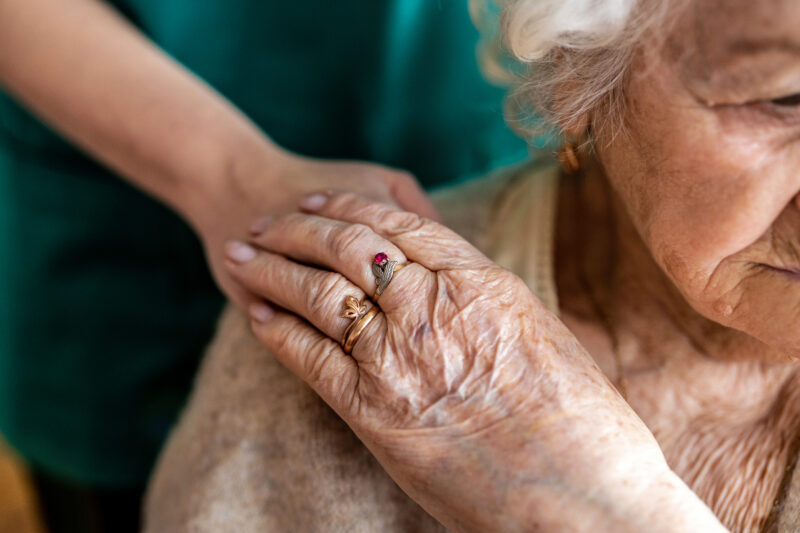If your loved one has been diagnosed with a terminal illness, it can be hard to face decisions about their end-of-life care—especially when to consider home hospice. Many family members put off making the difficult call because it feels like they’re giving up hope, but consulting with hospice sooner can actually improve the quality of life in a loved one’s last months.
“There’s a common misconception that we can only help patients when they are very close to death,” said Tammy Ennor, quality compliance director of Family Hospice in Belleville, Illinois. “But we can do so much more for them and their families when we get involved early.”
Ennor said the main goals of hospice are to improve a patient’s comfort level and to provide emotional support, allowing them to enjoy what’s left of their lives. According to the National Hospice and Palliative Care Organization, one-third of hospice patients receive care only during their last days, which means they miss out on multiple advantages of hospice services. Early intervention allows compassionate nurses to help patients live comfortably in their own homes, and to spend quality time with their family.
“From the time a patient is told nothing else can be done to extend their life, we can start building a relationship with them,” Ennor said. “We not only relieve their pain to make them feel better, but we gain their trust so they know someone will be by their side throughout their journey.”
As soon as a doctor estimates a life expectancy of six months or less, Ennor encourages family members to reach out to hospice.
Is my loved one eligible for hospice?
After calling a local hospice provider regarding a patient’s eligibility, a hospice team member will come to evaluate their condition and then pass that evaluation on to a physician for approval. Your loved one may be eligible for care if:
- They have been diagnosed with a terminal illness, such as Alzheimer’s, cancer, heart disease, liver disease, or a neurological condition such as Parkinson’s, with a life expectancy of six months without further treatment.
- They are visiting the ER more frequently or are being hospitalized more often.
- They need help performing daily tasks, such as getting out of bed, bathing, getting dressed, using the bathroom, and eating.
- They are losing weight more rapidly.
- They are falling frequently.
- They have shortness of breath even when resting or rely on an oxygen machine to breathe comfortably.
- They must take heavy pain medications to get through the day.
- There are noticeable changes in their mental awareness and cognitive function.
- They have Medicaid or Medicare coverage. Often, patients and caregivers avoid contacting hospice immediately after a terminal diagnosis due to concerns about cost, but most hospice services, medications and equipment are fully covered by Medicaid and Medicare.

How soon will home hospice care begin and what services can we expect?
Just as every patient’s situation differs, so does the availability of care at various hospice providers. Ennor said Family Hospice usually sees new patients from two hours to two days after approval, but some larger organizations may take longer.
During the first visit, a registered nurse will order medications and supplies needed to keep the patient comfortable, and within five days, a licensed social worker will meet with family caregivers to formulate a care plan. An interdisciplinary team of speech, physical and occupational therapists (along with home health aides) may also come for an initial visit. After that, every measure will be made to improve the patient’s comfort level and ease the burden for family members. Hospice services include:
- Special equipment setup including a hospital bed, lifts, wheelchair and oxygen machines
- Nursing visits to address physical symptoms such as pain and nausea, and any wound dressing needed
- Visits from a personal care aide to help with bathing and grooming
- Social work visits to help with community resources if family caregivers are not available
- Visits from a chaplain for spiritual comfort
- Emotional counseling to help the patient and family with grief and loss
- Respite care (a short-term stay in a hospital to give family members a break)
- Bereavement support for the family after their loved one has passed
Does my loved one have to stay in hospice care?
Surprisingly, it’s not uncommon for patients to “graduate” out of home hospice care. Sometimes diseases stabilize and a patient’s health improves because hospice has been monitoring their care so closely. If this happens, a patient can request to stop or pause hospice care until their condition declines, at which point they can begin hospice services again.
With home hospice, the end of life doesn’t have to be traumatic
A terminal illness diagnosis is difficult for patients and their families, but with the right kind of care plan, those last months can be spent enjoying time together. If your loved one has expressed interest in home hospice care or is showing signs of needing pain management, assistance with bathing and grooming, and emotional support, consider calling hospice. It doesn’t mean you’re giving up hope; it means you know your loved one should have all the care and support they deserve.
“Dying doesn’t have to be treated as an emergency,” Ennor said. “By involving hospice early, patients can express all the things they need to say, and family members can celebrate their loved one’s life while they’re still here.”

